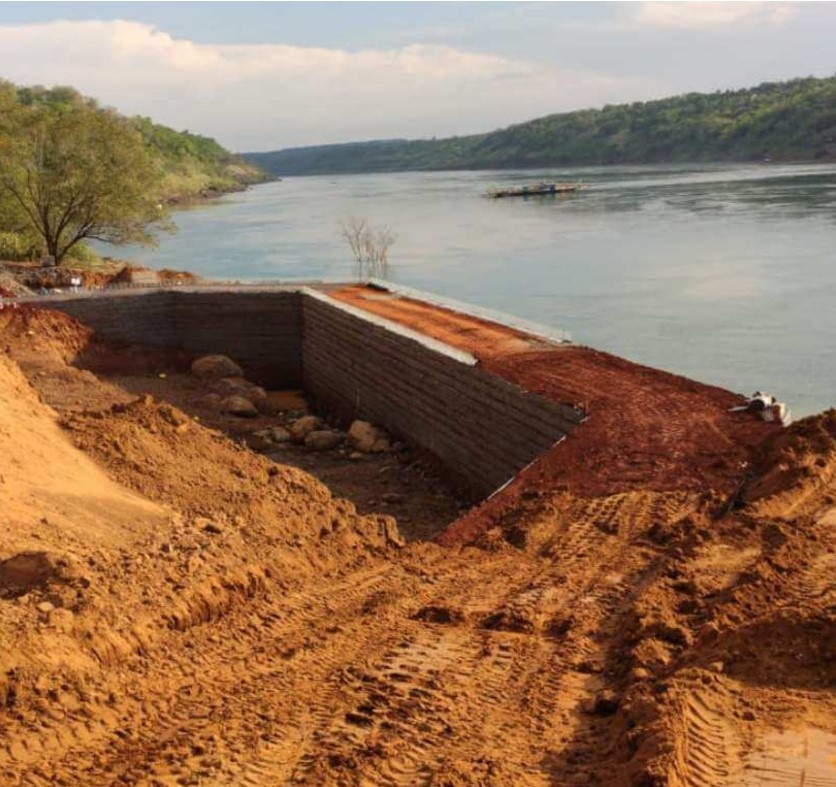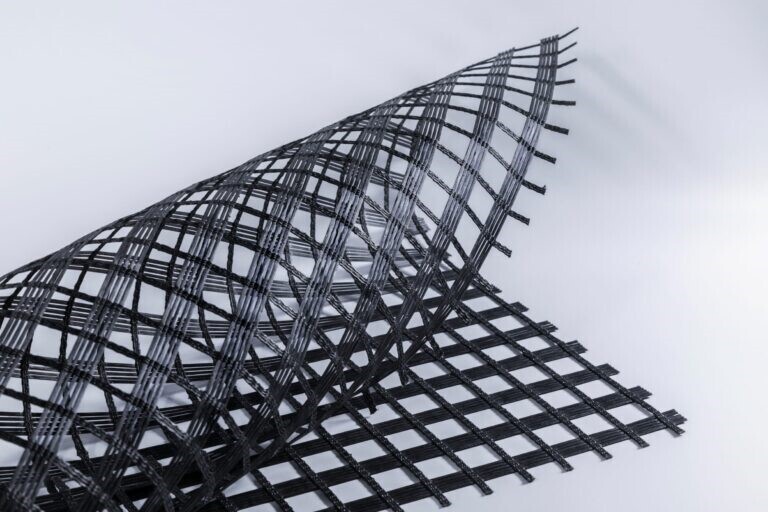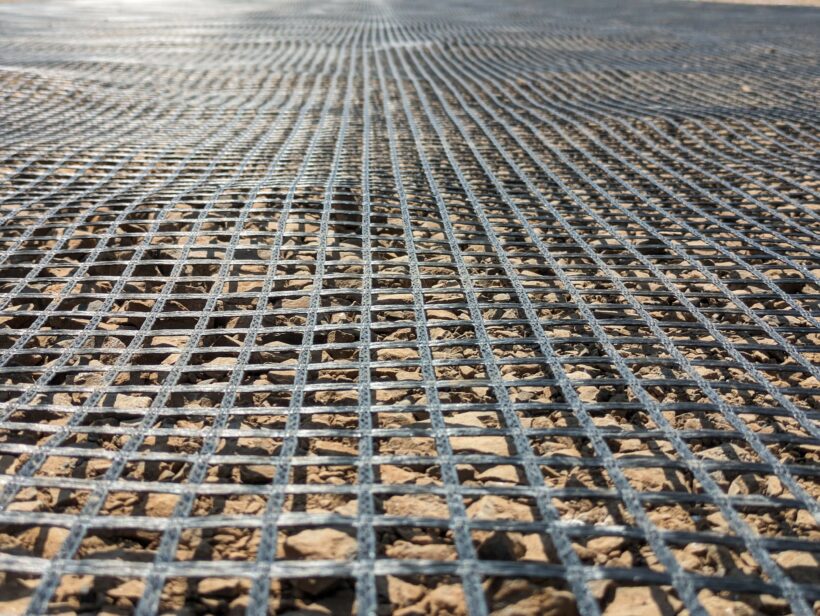What are the physical properties of geogrids?
Geogrids are geosynthetic materials used for reinforcing and stabilizing soil structures. They have high tensile strength and a higher elastic modulus than soil, allowing them to distribute loads more effectively and provide better reinforcement in construction applications than would otherwise be possible. Geogrids can be used in soil reinforcement, retaining wall reinforcement, slope stabilization, and more. “Geogrids are formed by intersecting grids of elements extending in two directions: one along the machine’s direction (MD) and the other in the cross-machine direction (CMD), forming the apertures. These apertures vary depending on the application and the manufacturer’s specifications. Geogrids are made of different polymer materials such as polyester, polyvinyl alcohol, polyethylene, or polypropylene. At Strata Geosystems, we manufacture PET geogrids.
The successful reinforcement with geogrids depends on three properties: physical, mechanical, and environmental. Physical properties, such as tensile strength, elongation, and flexural rigidity, influence the initial interaction with the soil. Mechanical properties, which include creep resistance, junction strength, and interface friction, govern the long-term performance of geogrids under stress exuded by the soil. Lastly, chemical and environmental properties address the geogrid’s resistance to biological and chemical degradation from surrounding elements.
Properties of geogrids
Ultimate tensile strength
The ultimate tensile strength of geogrids refers to the maximum load a geogrid can withstand before experiencing failure or breaking under tension. It is a crucial property that determines the performance and durability of a geogrid in resisting tensile forces in applications like soil reinforcement, road stabilization, and maintaining structural integrity. The ultimate tensile strength is typically expressed in units such as kN/m or lb/ft.
Elongation at ultimate tensile strength
The elongation at ultimate tensile strength property of geogrids refers to the percentage increase in length that occurs before a geogrid breaks under tension. It is a critical measure of the geogrid’s ability to deform before reaching its breaking point. This property helps engineers and designers evaluate the deformation characteristics of geogrids and make informed decisions regarding their suitability for construction projects based on their elongation capabilities before failure.
Aperture size and shape
The aperture size and shape determine how well the geogrid interacts with soil particles, distributes loads across its junctures, and provides stabilization. Different aperture sizes are designed to properly confine various fill particle sizes, ensuring effective load distribution and stabilization. Geogrids with different aperture shapes, such as triangular, hexagonal, or trapezoidal, offer unique responses to loads and soil interactions, impacting their overall performance.
Thickness and weight
The thickness of a geogrid is a critical factor that determines its durability, load-bearing capacity, and ability to provide reinforcement or stabilization. Geogrids with different thicknesses are used based on the specific requirements of a project, with thicker geogrids typically offering higher strength and stability. The weight of a geogrid is another essential property that impacts its handling, installation, and overall effectiveness. The weight of a geogrid is influenced by factors such as material composition, aperture size, and overall design.
Flexural rigidity
Flexural rigidity refers to the resistance to bending or flexing of a geogrid when subjected to external forces. It influences the geogrid’s performance in stabilizing weak pavement subgrades, reinforcing soil structures, and enhancing load-bearing capacity. It is essential to select the most suitable type of geogrid based on its bending characteristics and load-bearing requirements.
Resistance to installation damage
Geogrids are subjected to various stresses during installation, and their ability to resist damage during this process is essential for maintaining their structural integrity and effectiveness in providing stabilization or reinforcement. The resistance to installation damage is typically assessed through standardized testing methods like ASTM D5818, which evaluate the geogrid’s ability to withstand installation stresses without compromising its functionality in projects such as road construction, soil reinforcement, and slope stabilization.
Mechanical properties of geogrids
The mechanical properties of geogrids define how they respond to external forces and loads. These properties include:
Creep resistance
Over time, geogrids can become susceptible to creep, a gradual deformation under continued load. The creep rate of geogrids is dictated by the materials used and their manufacturing process. It is critical to select geogrids with low creep properties to ensure they maintain their tensile strength and provide effective reinforcement over the design life of the project. This highlights the importance of selecting geogrids with low creep properties to ensure they maintain their initial tensile strength and reinforcement effect over the life of the project. Research suggests creep strains for knitted and woven geogrids can range from 7.52% to 9.85%.
Junction strength and efficiency
Geogrid ribs intersect at specific points, known as junctions, for load transfer. Optimal junction strength helps these connections withstand the forces exerted during soil interaction. A geogrid’s junction efficiency is the actual strength of a geogrid junction compared to the theoretical strength of the geogrid material. A high junction efficiency denotes minimum strength loss at the connection points, increasing the geogrid’s reinforcement properties.
Interface friction
This refers to the frictional resistance between the geogrid and the surrounding soil or aggregate material. The interface friction coefficient between the geogrid and the soil is a key parameter that influences the load transfer mechanism, shear strength, and overall behavior of the reinforced structure. The value of this coefficient is determined by factors such as the internal friction angle, normal stress, and the specific characteristics of the soil and geogrid materials.
Chemical and environmental properties of geogrids
Resistance to chemical degradation
Geogrids are exposed to various chemical substances present in the soil or surrounding environment, resulting in loss of structural integrity. Geogrids with good resistance to degradation can maintain their strength, stiffness, and overall performance over an extended period, ensuring their durability and effectiveness in soil reinforcement, road construction, and other civil engineering applications.
Resistance to biological degradation
Microorganisms and other biological factors, such as fungi and insects in the soil, can cause the degradation of geogrids. High resistance to biological degradation helps maintain functionality of geogrids and provides high strength in the reinforcement of the soil. Industry standards, such as ASTM D 6703, outline test methods for evaluating a geogrid’s resistance to fungal and bacterial degradation.
Environmental sustainability
Despite being made from polymers, geogrids contribute to the sustainable reinforcement of soil. They help curtail quarrying activities and transportation emissions by reducing the need for excessive amounts of traditional construction materials like concrete and asphalt. Geogrids bolster the durability of structures they reinforce, leading to extended service life and reduced maintenance needs. This longevity helps in conserving resources and reducing the overall environmental impact of construction activities.
Applications of geogrids
Geogrids offer versatile solutions for many geotechnical engineering applications by enhancing the stability and performance of structures:
Reinforcement of soil in retaining walls and slopes
Geogrids excel in reinforcing soil within retaining walls and slopes. The stability of backfill soil in retaining walls is significantly influenced by the friction angle between the soil and geogrid, with high creep resistance ensuring long-term performance. Geogrids enhance slope stability by controlling deformation behavior. Research demonstrates that strategically positioned geogrid reinforcement improves the response to loads and settlements, as well as the bearing capacity. Key factors affecting bearing capacity include geogrid length, edge distance, and soil particle size.

Stabilization of road bases and foundations
In the construction of pavements and roads, geogrids contribute to enhancing subgrade conditions, reinforcing base courses, sub-bases, and surface layers. They mitigate the problem of lateral displacement of railway ballast, minimizing track settlement caused by weak soils. When dealing with clayey subgrade soils in pavements, geogrid reinforcement raises the pressure needed to penetrate the composite soil foundation. Rigid geogrids exhibit superior performance in soft subgrade conditions compared to flexible alternatives, thanks to their quicker reaction to applied loads.
Erosion control
Geogrids efficiently combat soil erosion using a dual strategy. Initially, they strengthen the soil matrix by redistributing stresses, boosting its load-bearing capacity. This increased resilience reduces the soil’s vulnerability to erosion caused by wind, rain, and external forces. Additionally, by reinforcing the soil matrix, the geogrid increases the soil’s shear strength and stability, making the overall structure much less vulnerable to erosion caused by water runoff and other forces.
What makes Strata Geosystems geogrids best in class?

Strata Geosystems geogrids offer innovative solutions tailored to various applications in geotechnical engineering, providing cutting-edge solutions to the applications mentioned above. These geogrids are meticulously designed to enhance essential properties, ensuring excellence and durability in soil stabilization, erosion control, highway infrastructure, roadway improvements, reinforced steep slopes, retaining walls, energy projects, landfill construction, and more.
StrataGrid, a high-performance uniaxial geogrid utilized in soil reinforcement solutions, is created by weaving high-tenacity polyester yarn into a stable network of apertures to form a geometric grid. Its exceptional tensile strength and high molecular weight provide reinforcement for both vertical and horizontal structures, while its trademarked UV-stabilized coating ensures durability against environmental factors—whether installation-related strains or soil conditions. StrataGrid offers leading elongation and stress-strain values, guaranteeing a structure lifespan exceeding 100 years. With widths up to 5.7 m, a wide range of ultimate tensile strengths up to 800 kN/m, and adherence to international guidelines like Ministry of Road Transport and Highways (MoRTH), Indian Roads Congress (IRC), and American Association of State Highway and Transportation Officials (AASHTO), StrataGrid is certified and tested by the Indian Institute of Technology (IIT) for quality assurance.

The StrataGrid biaxial (SGB) geogrid is a groundbreaking innovation in pavement construction that revolutionizes the durability and longevity of flexible pavements, particularly in highway embankments. These biaxial geogrids, engineered with the highest quality materials, offer exceptional tensile resistance at lower elongations, surpassing conventional solutions in the market. With a strength ranging from 20kN/m to 150kN/m and a width of 5m, SGB grids provide superior reinforcement for pavement base layers, resulting in reduced maintenance costs and extended pavement life. One of the key advantages of the SGB Grid series is its ability to reduce pavement crust thickness, leading to a faster and more efficient construction process. StrataGrid HyTen, comprises geogrids with unparalleled strength, boasting tensile strengths exceeding 200 kN/m (13,704 lbs/ft).
Our specialized line of geogrids is primarily used in the construction of embankments over soft soil grounds, including organic peat and clay-type soils. By employing safe design methods, StrataGrid HyTen allows for direct construction on challenging soil types. It effectively limits vertical settlements and provides a solid reinforced soil foundation over voids, ensuring stability and longevity. To learn more about Strata Geosystems’ geogrid and how we can benefit your construction projects, please reach out to our team for expert consultation and guidance.
Click here to contact us and discover how our geogrids can help you achieve resilient, efficient, and environmentally conscious infrastructure development.
